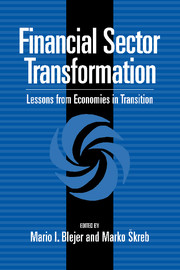11 - The Financial Sector in Transition
Published online by Cambridge University Press: 05 November 2011
Summary
As the chapters in this volume have clearly revealed, the process of financial reform and capital market development is one of the most intricate aspects of the postsocialist transition and one that is probably among the most controversial and least understood. This is so not just because it encompasses the expansion of a set of economic activities that were totally neglected and therefore completely underdeveloped under the central planning regime, but also because it involves the promotion of institutional arrangements and the implementation of technical procedures for which there is no full consensus even in advanced market economies.
The studies collected here provide a thorough examination of the problems and the experiences related to the emerging financial sectors in transition economies. While an attempt to generalize and summarize conclusions cannot be all-encompassing, it could be useful to derive some inferences that seem to have general validity. Without seeking to be comprehensive, it is possible to organize the major questions dealt with in this volume around seven major issues, most of which raise new questions and should elicit further research and inquiry.
MONETARY POLICY! A SHIFT TOWARD INDIRECT INSTRUMENTS
The major modifications in the functioning of financial markets and financial institutions brought about by the post-Communist transition gave rise to drastic changes in the role and in the instrumentation of monetary policies. Monetary policy became an active policy tool, and there has been a marked shift throughout the region toward the introduction of more market-oriented monetary instruments.
- Type
- Chapter
- Information
- Financial Sector TransformationLessons from Economies in Transition, pp. 383 - 392Publisher: Cambridge University PressPrint publication year: 1999

